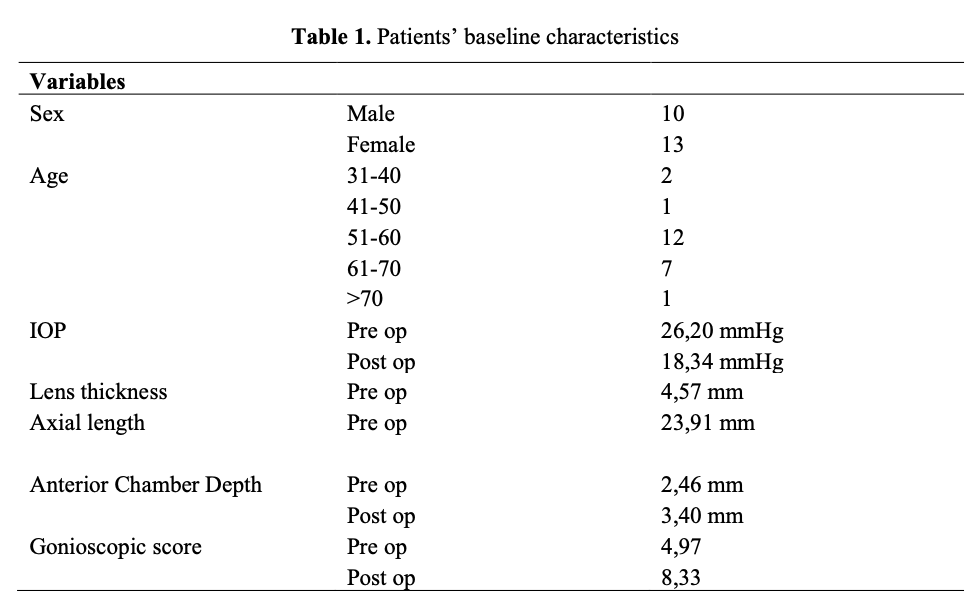SUCCESS RATE OF GLAUCOMA DRAINAGE DEVICE IMPLANTATION IN KARIADI GENERAL HOSPITAL SEMARANG 2020 – 2022
Abstract
Introduction: Glaucoma is a leading cause of irreversible blindness, and implantation of drainage devices is an effective treatment option for patients with advanced glaucoma. The purpose of this study was to investigate the success rate of glaucoma drainage devices implantation in Kariadi Hospital.
Methods: This was an observational analytic study with a retrospective design. All patients who received Virna implantation between January 2020 and December 2022 were included. Intraocular pressure (IOP) examination was performed at the baseline and at the first day, at the seventh day, at the first month, and at the third month after surgery. The success rate was divided into three groups: complete success if IOP was <21mmHg without medication, qualified success if IOP was <21mmHg with medication, and failure if IOP was >21mmHg with medication.
Results: This study included 42 patients (42 eyes) with an average age of 43.3 years. There were 16 male (38%) and 26 female (62%) patients in the group. From these patients, 11 (26.2%) had primary glaucoma and 31 (73.8%) had secondary glaucoma. There was a significant decrease in IOP from preoperative measurement (37.1±10.1mmHg) compared to IOP on the first day (13.0±6.0mmHg), on the seventh day (15.4±3.8mmHg), on the first month (18.2±4.4mmHg), and on the third month (23.4±8.9mmHg) after surgery (p<0.05). At three-month follow-up, the complete success was 14.29%, the qualified success was 50%, and the failure was 35.71%.
Conclusion: Glaucoma drainage device implantation was found to successfully reduce IOP in patients with advanced glaucoma. The qualified success rate was higher than complete success rate, suggesting that some patients may require medication to achieve target IOP levels.
Full text article
References
Jacobson A, Besirli CG, Bohnsack BL. Outcomes of Baerveldt Glaucoma Drainage Devices in Pediatric Eyes. Glaucoma J. 2022;31(6):468–77.
Lee CK, Ma KT, Hong YJ, Kim CY. Long-term Clinical Outcomes of Ahmed Valve Impantation in Patients with Refractory Glaucoma. PLOS One J. 2017;12(11):1–13.
Elhusseiny AM, Vanderveen DK. Outcomes of Glaucoma Drainage Devices in Childhood Glaucoma. Semin Ophthalmol. 2020;35(3):194–204.
Hong M, Peng Y, Lai Y, Zheng Q, Hong C. Comparison of Aurolab Aqueous Drainage Implant with Ahmed Glaucoma Valve for Refractory Glaucoma: A Meta-Analysis. Ophthalmic Res. 2023;445–52.
Schwartz KS, Lee RK, Gedde SJ. Glaucoma drainage implants: A critical comparison of types. Curr Opin Ophthalmol. 2006;17(2):181–9.
Chaku M, Bajwa A, Lee JK, Netland PA. Treatment of Uveitis and Outcomes of Glaucoma Drainage Implant Surgery: A Meta-Analysis. Ocul Immunol Inflamm. 2020;28(5):833–8.
Oktariana AVD. Virna Glaucoma Implant Glaucoma Drainage Device untuk Glaukoma Refrakter. In Continuing Ophthalmology Education 2019 Anterior Segment Procedures: Resolving The Problems. Universitas Indonesia Publishing. 2019. 107–110 p.
Stallworth JY, O’Brien KS, Han Y, Oatts JT. Efficacy of Ahmed and Baerveldt glaucoma drainage device implantation in the pediatric population: A systematic review and meta-analysis. Surv Ophthalmol. 2023;68(4):578–90.
Rodgers CD, Meyer AM, Sherwood MB. Relationship between glaucoma drainage device size and intraocular pressure control: Does size matter? J Curr Glaucoma Pract. 2017;11(1):1–2.
Yoon D, Vajaranant T. A Meta-Analysis on the Outcome of Sequential Glaucoma Drainage Implantation. J Glaucoma. 2020;29(3):184–90.
Authors
Copyright (c) 2024 Rina Apriliana, Fifin L. Rachmi, Maharani Maharani

This work is licensed under a Creative Commons Attribution-NonCommercial-ShareAlike 4.0 International License.


